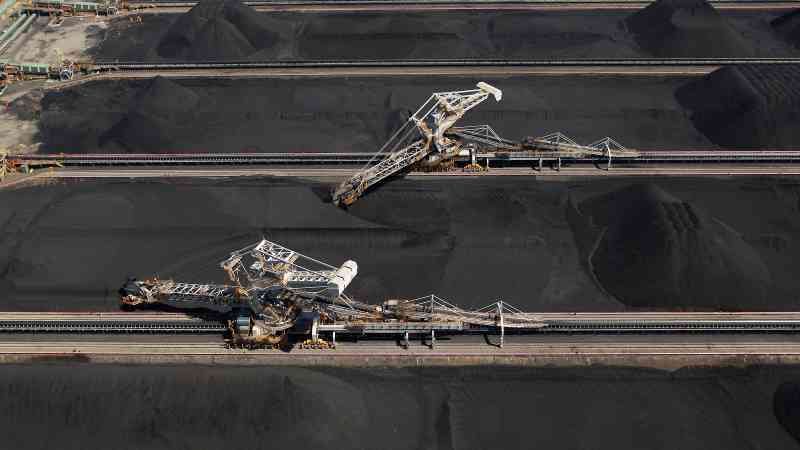Glencore has abandoned a proposal to spin off its coal division after more than half of shareholders sought to retain ownership of the lucrative but heavily polluting business.
The FTSE 100 miner said that 63 per cent of its investors backed keeping the fossil fuels assets — rather than listing the division on the New York Stock Exchange — and deploying the cash generated to fund expansion into “green’” transition metals and to “accelerate and optimise the return of excess cash flows”.
Gary Nagle, Glencore’s chief executive, argued that the decision would be better for the environment than divesting the coal assets because the London-listed miner could be trusted to minimise the operations’ impact on the environment.
• If Glencore retains coal, what will it mean for climate targets?
Nagle said that “sense is starting to prevail” in the debate over environmental, social and governance (ESG) issues for mining companies and that “some of the most left-leaning” non-governmental organisations supported listed groups holding on to coal.
He added: “The general and overwhelming feedback was that spinning out the coal business was in fact ESG-negative, and keeping it in Glencore’s hands, with its responsible operation practices and responsible run-down strategy for the thermal coal business, is far better than spinning it out. Who knows what the unintended consequences of that spin-out decision is and what would happen if it is in new hands?”
Glencore has expanded its coal exposure over the past year by purchasing Elk Valley Resources, a steelmaking coal business, from the Canadian miner Teck Resources for $6.9 billion.
The FTSE 100 company had planned to split off its coal division post-acquisition to focus on transition metals such as copper, which is used to manufacture electric vehicles, wind turbines and other infrastructure projects required for a global shift to renewable energy.

He said: “This was primarily on the basis that retention should enhance Glencore’s cash-generating capacity to fund opportunities in our transition metals portfolio, such as our copper growth project pipeline, as well as accelerate and optimise the return of excess cash flows to shareholders.”
Analysts at Jefferies said that cash from Glencore’s coal could also help to fund acquisitions for additional assets, such as Anglo American’s steelmaking coal business. Anglo is seeking to sell the division to help lift its share price after BHP’s bid for the company earlier this year.
• Buyers ready to dig deep for world’s miners
However, the analysts added: “A risk is that increased coal exposure could put further downward pressure on Glencore’s equity valuation.”
The Australasian Centre for Corporate Responsibility (ACCR) has calculated that Glencore’s acquisition of Elk Valley Resources (EVR) will increase its inventory of coal by more than 30 per cent until its mines stop operating.
Naomi Hogan, company strategy lead at the ACCR, said: “With the EVR acquisition complete and the coal business to stay, Glencore’s climate plan is now outdated. Glencore needs to move swiftly and give investors much needed visibility on how it plans to manage its increased exposure to climate transition risk.
“With the announcement that the demerger is not going ahead, we expect Glencore to commit to an updated climate plan as a matter of priority. Investors need to understand the impact this coal acquisition has on Glencore’s emissions reductions targets.”
Glencore’s interim results hit by coal price declines
Glencore’s commitment to coal aided its shares on Wednesday despite the company missing its earnings estimates on the back of a sharp decline in prices for the fossil fuel.
The miner’s group adjusted earnings before interest, tax, depreciation and amortisation (Ebitda) came in lower than expected as they fell 33 per cent to $6.3 billion in the six months ended June 30.
The company was held back by a decline in thermal coal prices and was unable to meet analysts’ expectations for earnings before deductions of between $6.8 billion and $6.9 billion.
The prices on the Newcastle and AP14 thermal coal benchmarks were down by 36 per cent and 22 per cent respectively over the six-month period, compared with the same half year in 2023. Copper prices were up on average by 4 per cent, and zinc prices declined by 7 per cent.
The company delivered a 9 per cent increase in revenues from $107 billion to $117 billion and its decision to stick with coal helped its shares rise by or 11p, or 2.8 per cent, to close at 404¼p.
Analysts at RBC Capital Markets said that Glencore’s shares were likely to rise this year as it is the only miner not exposed to iron ore during a period when prices for the metal are expected to lag other commodities such as copper and coal.
They said the company’s share price would be driven by its “attractive valuation, commodity exposure and the potential for special distributions”.
Jefferies said any pressure on Glencore’s share price from its exposure to coal could be addressed by moving its primarily listing to the US, where coalminers command higher valuations.
